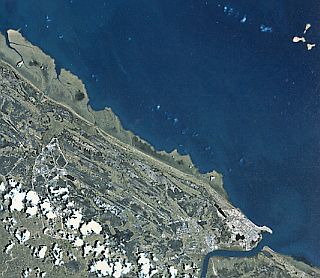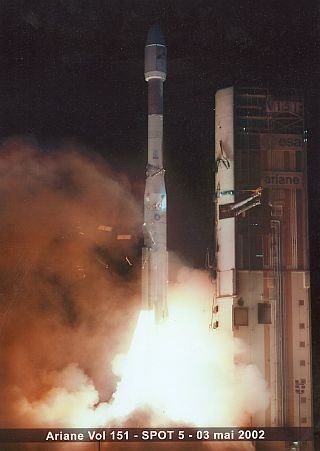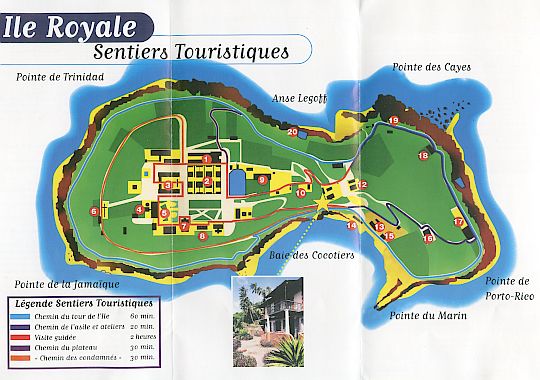|
Papillon
- Henri Charrière
|
||||||||||||||||
|
|
||||||||||||||||
|
1) My father bought a precursor called "I escaped from Devil's Island" sometime in the 1940s, which I read in the mid-50s. It was written in 1938 by an escaped convict, René Belbenoît, and originally published under the title "Dry Guillotine". 2) Henri Charrière's "Papillon" was published in France in 1968 and was an instant success. I read it on the beach a few years later. 3) "Papillon" was turned into a terrific movie in 1973, starring Dustin Hoffman and Steve McQueen. 4) I was finally able to visit the Iles du Salut in connection with a satellite launch in 2002. Charrière's memoir decribes his experiences as a convict in France's feared penal colonies in French Guyana in the 1930s and 40s, and his numerous attempts to escape, ultimately crowned with success. Just as Britain had used Australia and North America to get rid of undesired prisoners in colonial times, and to populate their colonies, France dumped many of its hardened criminals in places such as New Caledonia and French Guyana. The practice continued in French Guyana until 1946. The early attempts to colonize the territory had been less than successful due to the appalling conditions (malnutrition and tropical diseases) and the abolition of slavery in 1848. A century earlier, some of the pioneering colonists had relocated to the Iles du Salut, off the Guyanese coast, opposite the town of Kourou, which were found to have a healthier climate, hence their name (Salvation Islands).
From 1852 criminals and political prisoners were regularly shipped to French Guyana, most of them condemned to hard labor on the mainland. If they survived their prison term, they had to remain in French Guyana for as long as their prison term had lasted ("doublage"). Thus the majority in practice served a (mostly short) life sentence. The worst offenders, and those judged most likely to attempt to escape, were interned on the Iles du Salut, which are made up of three islands. Even the main island, the Ile Royale, is just 1 km in length. Devil's Island, to the north, was where the most important prisoners were held. It was considered escape proof because of its inaccessible cliffs, the strong currents and the sharks. It is best known for the incarceration of Alfred Dreyfus, falsely accused of espionage for the Germans, for five years (1895-99). It is off-limits to visitors after a Chinese VIP guest drowned there some years ago. Some books are harder to put down than others. While I may find those of Hawking, Korzybski or Wittgenstein captivating, I have to admit that they are not exactly page-turners. Papillon is.
An arresting first sentence is always a good sign. Take García Márquez' "100 years of solitude": 'Many years later, as he faced the firing squad, Colonel Aureliano Buendía was to remember that distant afternoon when his father took him to discover ice.' Or Erica Jong's "Fear of flying": 'There were 117 psychoanalysts on the Pan Am flight to Vienna and I'd been treated by at least six of them.' Or take Alexandre Dumas' "Les Mohicans de Paris": 'Si le lecteur veut risquer, avec moi, un pèlerinage vers les jours de ma jeunesse...' etc. (Inspired by Dumas, I used a similar invitation to my readers in the prolog to my chronicle of the first 25 years of Swedish Space Corporation.) Charrière's opening sentence goes like this: 'The blow was such a stunner that it was thirteen years before I could get back on my feet again.' In the first chapter he is sentenced to penal servitude for life for a murder he claims he did not commit. Deportation to the prison system in French Guyana follows. The rest is a hair-raising account of the hardships of his prison existence, including the physical and psychological torture of two years of solitary confinement in total silence, and of his plans and attempts to escape. I will not divulge any details here, so as not to spoil the pleasure of those who have not yet had the opportunity to read the book! It is a fascinating journey through events that are not so far removed from our own age. It is also a sobering reminder (if one is needed) of how inhumanity can become institutionalized even in a civilized and democratic society. The veracity of Charrière's memoir has been questioned. It seems likely that he used material from other authors, and stories he had heard from other prisoners. He may have used Belbenoît's book as a source and as inspiration. And a certain Charles Brunier (1901-2007), claimed to be the real Papillon as late as 2005 (no doubt with some prodding from his prospective heirs), at the age of 104! In my opinion, it does not make a great deal of difference. We are not awarding a patent or a Nobel prize here! Nowadays, space activities form an important element of the local economy in Kourou. A major spaceport has been built in the vicinity. One of its attractions is that it lies almost on the equator, which means a free velocity boost of close to 0.5 km/sec for low-inclination orbits, due to the Earth's rotation. The first Ariane rocket was launched from there on Christmas Eve 1979. Today, it is a "booming business" in every sense of the word! - The total population of French Guyana is believed to be around 200,000 by now. I visited Kourou and Ile Royale in May 2002 together with the Director General of the Swedish National Space Board in connection with the launch of SPOT-5 (where Sweden is a partner). There were many French senior military people on the flight from Paris to Cayenne in French Guyana, who were getting a preview of the upcoming launches of their military observation and communication satellites. A bus took us from Cayenne to Kourou along the coast road. The day after arrival was spent visiting the space center, where "our" Ariane 4 vehicle was being prepared for launch. Lunch was served in a restaurant on the Kourou river. The commanding officer of the French Legion headed "my" table. The Legion is responsible for protecting the spaceport, but also for patrolling the borders of French Guyana. Not an easy task. Inland, the whole territory consists of dense jungle. To the south, there are infiltrators from across the Brazilian border. To the west, there is a border dispute with Surinam. After lunch we were taken on a boat trip on a river. Our French-speaking guide was very good and managed to convey his enthusiasm for camping out in the jungle. He had an enormous respect for the capabilities of the Indian tribes that inhabit the jungle further south. A European who gets lost in the jungle has slim chances to survive. "After 9 days we stop the search. If he is still alive, he is sure to have gone mad by then."
I had been very lucky. Most launches are delayed for one or several days due to technical issues or weather. This time it was more like Veni, vidi, vici. - Of course, spirits were high at the post-launch celebrations into the night. The following day, we were invited to visit the Iles du Salut, which have been put under the administration of CNES, the French space agency. The sea was calm, and the ferry trip was smooth. The sea itself is not as crystal clear as you might expect. It looked rather grey, I think due to the large quantities of silt that are dumped into the ocean by the Amazon river and carried along the coast by strong currents. We reached the Ile Royale, where several sailboats lay at anchor in its small harbor. The island has rather steep hillsides. French- and English-speaking guides took good care of us, but I soon broke away and went exploring the small island on my own.
|
 You
might say that I experienced this fantastic book no less than four
times:
You
might say that I experienced this fantastic book no less than four
times: 

 SPOT
satellites travel in a sun-synchronous orbit, i. e. the orbit plane
makes a complete turn in one year, so that the satellite always
passes over the equator at 10.30 a.m. going south. Launches into
polar orbit from Kourou always occur in a northerly direction. This
dictated a night launch for SPOT 5. I chose to witness the launch
from the Toucan outdoor observation hill 5 km from the launch site,
in preference to the Jupiter control center. It was a strange feeling,
sitting in the warm tropical night with a giant TV screen to one
side. I must have seen hundreds of launches on TV, so I thought
I knew what to expect, more or less: A blinding white light when
the first-stage boosters ignite, a slowly rising rocket, and after
15 seconds or so a deafening rumble when the sound from launch site
arrives. The part that took me by surprise was the next half minute,
as the rocket picked up speed and roared over our heads after passing
through a cloud band. You could really feel in your stomach how
much the rocket wanted to escape from the Earth. The power!
The night sky was clear where the rocket was going, and we could
observe it through booster separation, first stage separation and
several minutes after that.
SPOT
satellites travel in a sun-synchronous orbit, i. e. the orbit plane
makes a complete turn in one year, so that the satellite always
passes over the equator at 10.30 a.m. going south. Launches into
polar orbit from Kourou always occur in a northerly direction. This
dictated a night launch for SPOT 5. I chose to witness the launch
from the Toucan outdoor observation hill 5 km from the launch site,
in preference to the Jupiter control center. It was a strange feeling,
sitting in the warm tropical night with a giant TV screen to one
side. I must have seen hundreds of launches on TV, so I thought
I knew what to expect, more or less: A blinding white light when
the first-stage boosters ignite, a slowly rising rocket, and after
15 seconds or so a deafening rumble when the sound from launch site
arrives. The part that took me by surprise was the next half minute,
as the rocket picked up speed and roared over our heads after passing
through a cloud band. You could really feel in your stomach how
much the rocket wanted to escape from the Earth. The power!
The night sky was clear where the rocket was going, and we could
observe it through booster separation, first stage separation and
several minutes after that.

